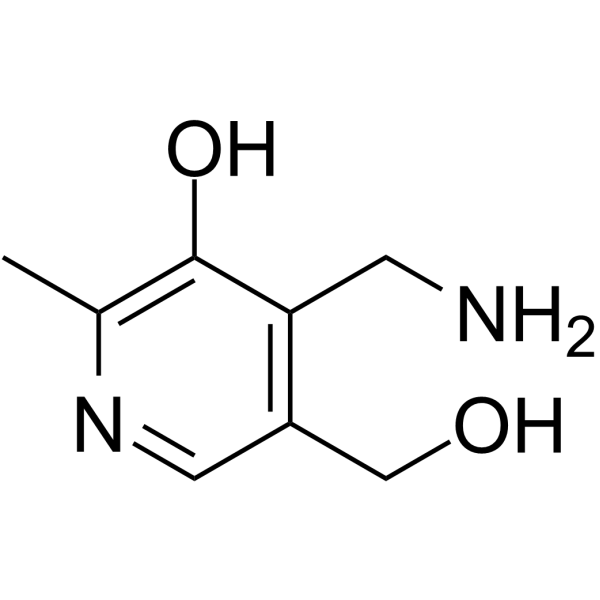
Pyridoxylamine
CAS No. 85-87-0
Pyridoxylamine( pyridoxamine )
Catalog No. M26401 CAS No. 85-87-0
Pyridoxylamine is an inhibitor of advanced glycation end production (AGEs) and lipoxidation end products (ALEs).
Purity : >98% (HPLC)
 COA
COA
 Datasheet
Datasheet
 HNMR
HNMR
 HPLC
HPLC
 MSDS
MSDS
 Handing Instructions
Handing Instructions
| Size | Price / USD | Stock | Quantity |
| 10MG | 34 | In Stock |


|
| 25MG | 55 | In Stock |


|
| 50MG | 80 | In Stock |


|
| 100MG | 115 | In Stock |


|
| 200MG | Get Quote | In Stock |


|
| 500MG | Get Quote | In Stock |


|
| 1G | Get Quote | In Stock |


|
Biological Information
-
Product NamePyridoxylamine
-
NoteResearch use only, not for human use.
-
Brief DescriptionPyridoxylamine is an inhibitor of advanced glycation end production (AGEs) and lipoxidation end products (ALEs).
-
DescriptionPyridoxylamine is an inhibitor of advanced glycation end production (AGEs) and lipoxidation end products (ALEs).(In Vitro):Pyridoxylamine (PM) is a member of the B6 vitamer family,and is a potent scavenger of reactive carbonyls, inhibiting the late stages of glycation reactions that lead to AGE formation.(In Vivo):In STZ diabetic rats, Pyridoxylamine inhibited the formation of CML and CEL and the cross-linking of skin collagen, ultimately inhibiting the development of nephropathy. Pyridoxamine does not appear to act as an antioxidant because it does not inhibit lipid peroxidation. However, it prevents modification of proteins by lipid peroxidation products, including inhibition of the formation of adducts of malondialdehyde and 4-hydroxynonenal on proteins in Zucker rats .
-
In VitroPyridoxylamine (PM), a member of the B6 vitamer family, is a potent scavenger of reactive carbonyls, inhibiting the late stages of glycation reactions that lead to AGE formation.
-
In VivoPyridoxylamine limits the formation of CML and CEL and cross-linking in skin collagen and, ultimately inhibits the development of nephropathy in STZ-diabetic rats. Pyridoxylamine does not appear to function as an antioxidant since it does not prevent lipid peroxidation reactions. At the same time, it does prevent protein modification by products of lipid peroxidation, including inhibiting formation of malondialdehyde and 4-hydroxynonenal adducts on protein in Zucker rats in vivo.
-
Synonymspyridoxamine
-
PathwayProteasome/Ubiquitin
-
TargetEndogenous Metabolite
-
Recptor——
-
Research Area——
-
Indication——
Chemical Information
-
CAS Number85-87-0
-
Formula Weight168.19
-
Molecular FormulaC8H12N2O2
-
Purity>98% (HPLC)
-
SolubilityIn Vitro:?DMSO : 16.67 mg/mL (99.11 mM)
-
SMILESOCC1=C(CN)C(O)=C(C)N=C1
-
Chemical Name——
Shipping & Storage Information
-
Storage(-20℃)
-
ShippingWith Ice Pack
-
Stability≥ 2 years
Reference
1.Keke Li, et al. Method for extracting and measuring 5 macamides in maca by using deep eutectic solvent.CN107748211B
molnova catalog



related products
-
N8-Acetylspermidine ...
N8-Acetylspermidine dihydrochloride is a polyamine that regulates ischemic cardiac apoptosis and resultant cardiac dysfunction.
-
N-Acetyl-L-tryptopha...
N-Acetyl-L-tryptophan?is an inhibitor of neurokinin 1 receptor (NK1-receptor, NK1R).
-
Pseudouridine
Pseudouridine is the most abundant modified nucleoside in non-coding RNAs. It enhances the function of transfer RNA and ribosomal RNA by stabilizing RNA structure.



 Cart
Cart
 sales@molnova.com
sales@molnova.com


